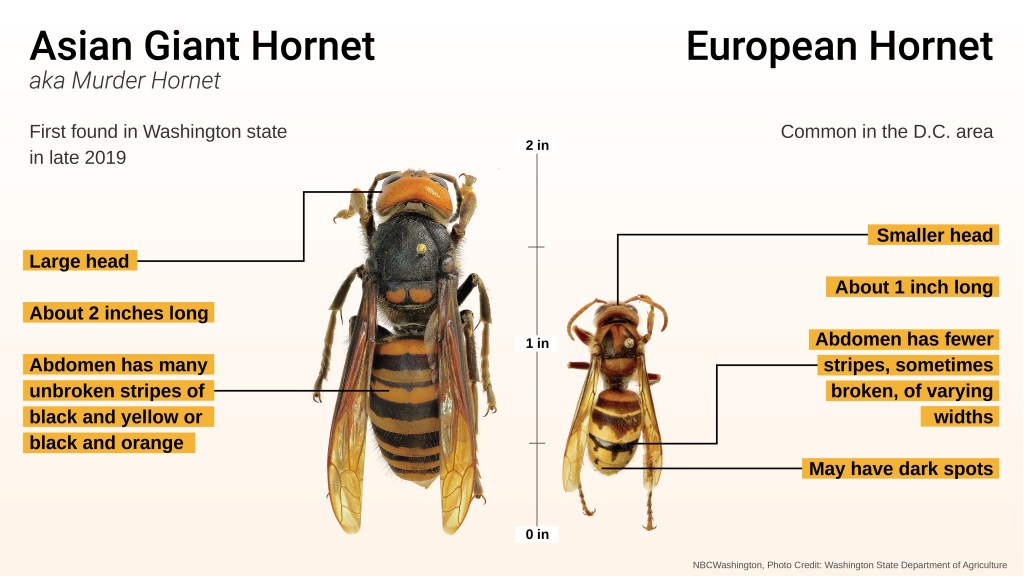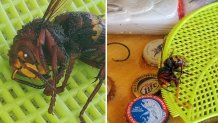What to Know
- Asian giant hornets, nicknamed murder hornets, can decimate honeybee hives and give humans a punishing sting. But none have been found in D.C., Maryland or Virginia.
- Hundreds of people in the region have contacted officials to report suspected murder hornet sightings. They’re often mistaken with European hornets, which are common here.
- Here’s how to tell the difference between the two and what to do if you still aren’t sure about what you saw.
Brook Stevens was building a tiki bar outside his home in Huntingtown, Maryland, last week when he saw it; a fat, black-and-yellow hornet at least an inch long.
Stevens, a 40-year-old dad, had just read online about the “murder hornet.” So he smacked the bug dead and snapped photos. He knew it would scare his 10-year-old daughter.
“I saw this thing and was like, ‘Uh, I wonder if that’s one,” he said.
University of Maryland entomologist Michael Raupp reviewed Stevens’ photos and ruled that the bug wasn’t an Asian giant hornet — the actual name of the insect; rather, it was a European hornet. The two are often confused.
While the Asian giant hornet can decimate honeybee hives and give humans a punishing sting, bug experts in the D.C. area say none have been found in the region and people here have little to worry about.
“There’s no need to panic for people here in the DMV. This particular situation should only be causing serious concern in the Pacific Northwest, Washington state and surrounding areas,” said Raupp, who has specialized in invasion biology for more than 40 years and runs a blog called Bug of the Week.
Local
Washington, D.C., Maryland and Virginia local news, events and information
Asian Giant Hornets
Hundreds of people in the D.C. area have contacted officials to report suspected sightings of murder hornets. Virginia tallied more than 110 calls and emails, most of which were from people who thought they saw the bug, a spokesman for the state's agriculture department said.
But the hornet has not been found in D.C., Maryland or Virginia — or anywhere in the United States except for Washington state.
People are suddenly worried about insects that were already present, said D.C. Department of Energy and Environment biologist Natasha Garcia Andersen.
“Just because you see it and think it’s an Asian hornet, it’s probably a cicada killer or a European hornet that you never noticed in your life until now,” she said.
The Asian giant hornet, which is the world’s largest hornet, can be almost two inches long, with a thick, striped body and sharp stinger. Just a few of the hornets can destroy a honeybee hive in a matter of hours, according to the Washington State Department of Agriculture. No one knows how they arrived in the U.S.
They are frequently mistaken for the European hornet, which does live in the D.C. area.

Here’s how to tell the difference: the Asian giant hornet is much larger and can be about two inches long. The area between its eyes and on its thorax is light in color. On its abdomen, it has unbroken stripes of black and orange or yellow. The European hornet is smaller than two inches and has fewer bands, which are broken or thin.
The Asian giant hornet, an invasive species, was first found in Blaine, Washington, in late 2019. One beekeeper went to check on his hives and found “thousands and thousands of bees with their heads torn from their bodies and no sign of a culprit,” he told "The New York Times” for a story that went viral. Officials have not confirmed that murder hornets were to blame in that attack, but two were later discovered a few miles away.
The hornets post guards at the entrance of a hive, slaughter bees inside and outside the hive and decapitate them, Raupp explained. They chew up the bee flesh and fly back to their colony with “meatballs” to feed their babies and queen.
For humans, the hornets can give a painful sting if they’re threatened or disturbed from their homes, which are generally underground in abandoned rodent burrows or decaying tree roots. Their venom is less powerful than that of a honeybee, but the volume is much greater, Raupp said.
“When you get stung, you’re getting a real, full-dose wallop,” he said.
In rare cases, multiple stings can cause death, an analysis of cases in Japan found.
What makes Asian giant hornets scary is the damage they could do to the honeybees we need to pollinate crops, not any threat they pose to humans, said Garcia Andersen, the D.C. government biologist.
“The main issue with these is just the damage that they could cause,” she said.
It will be years or even decades before we have to deal with the Asian giant hornet in the D.C. area, both Garcia Andersen and Raupp said they expect. However, all it takes is a “single, impregnated female wasp,” Raupp said. She alone can found a colony.
If you saw a large hornet and you're unsure what you saw, take a photo and send it to your local department of agriculture or extension service, such as those at universities, the experts said.

Though the insects have "murder" in their nickname and they do pose a threat to bees, they’re not malicious, Raupp said.
“These are not evil creatures. These are just animals that are trying to go about their business,” he said. “It’s just unfortunate for us that means killing honeybees.”



